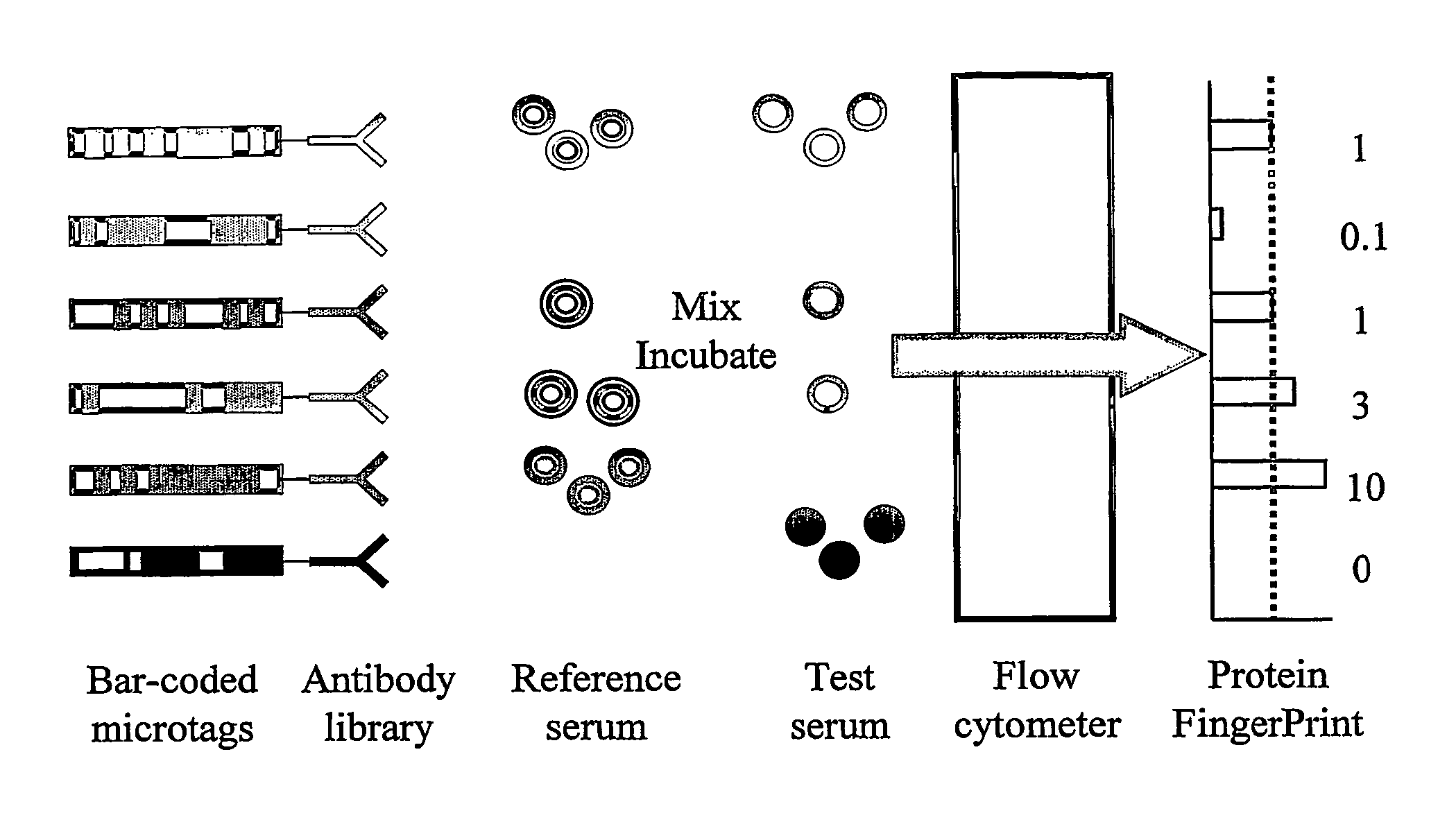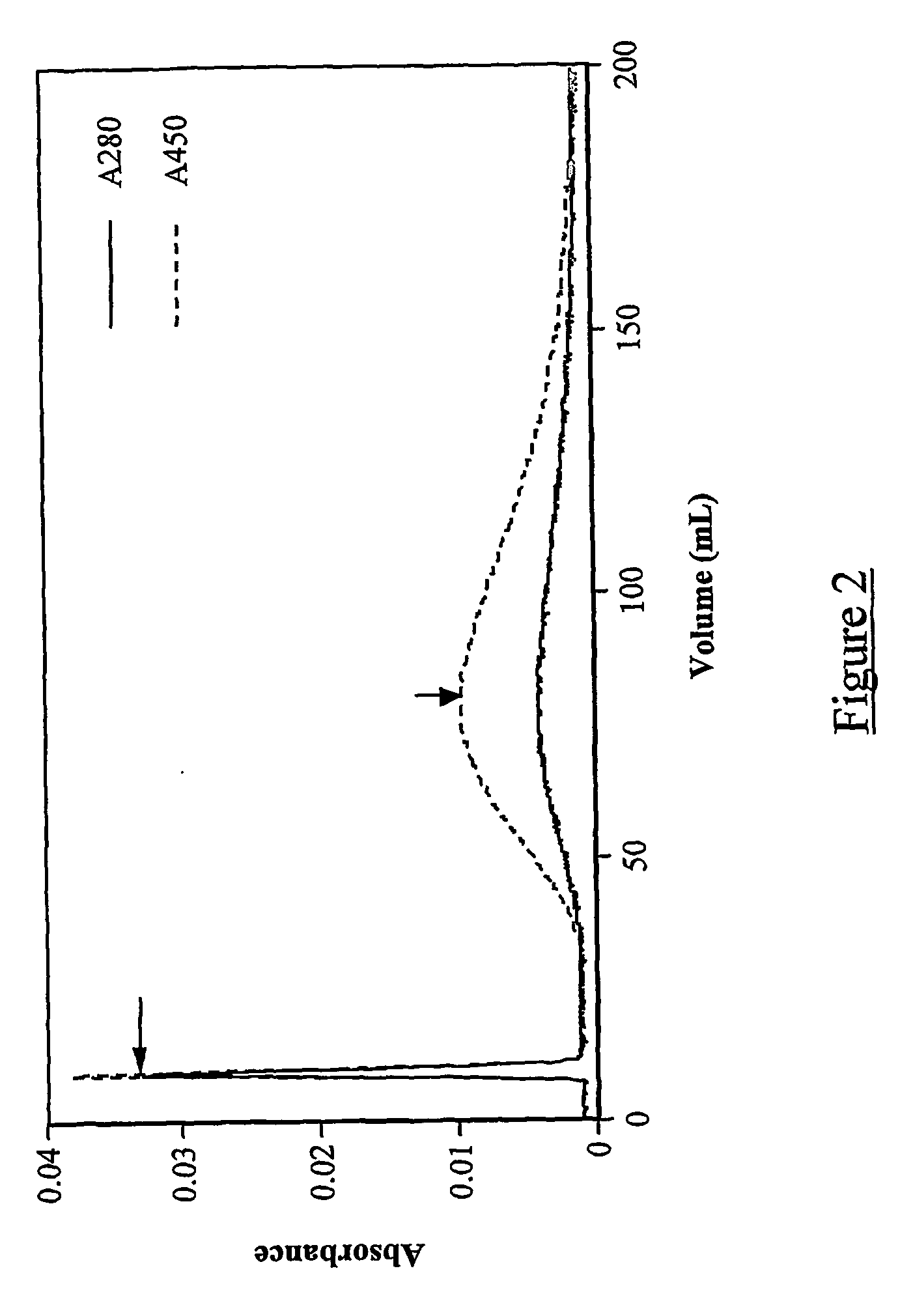Immunoassay
- Summary
- Abstract
- Description
- Claims
- Application Information
AI Technical Summary
Benefits of technology
Problems solved by technology
Method used
Image
Examples
example 1
A Proteomic Analysis of Human Serum Using a Small Antibody Library Aluminium Bar-Code Tags and a Fluorescein Labelled Reference Sample
[0175] In the first step, an antibody library suitable for use in DMI was generated. For this pilot demonstration of the invention, the library was constructed by obtaining quantities of purified antibodies against human serum components from a range of manufacturers. Each of the antigens to be studied was included in the library just once, and as a result the library had the ideal characteristic for DMI libraries of very low redundancy.
[0176] For this experiment, thirty eight different antibodies were selected. Thirty-four were against distinct serum components (see Table 1). The remaining 4 were control antibodies of the same species as the 34 antibodies, but with epitopes selected to be absent from the reference sample. The 34 serum components to be detected in this experiment ranged in abundance from albumin (˜30 mg / ml) to IL-1b (100 pg / ml). How...
example 2
Generation of a Large Scale DMI Antibody Library from an Unselected Phage Display Library with Very High Coverage
[0186] In example 1, we used a manually constructed small DMI antibody library to illustrate the principle of the approach. However, as with any megaplex technology capable of managing thousands of analytes in parallel, the power of the approach increases with the size of the library. It is not feasible to construct libraries larger than 100 or so components by the manual method, so an alternative is required for large libraries. Furthermore, a manually constructed library will only represent “known” antigens (that is, ones already known or suspected to be present in the test samples). In contrast, a library generated by sub-selection from a phage-display library will be both much larger and likely to contain antibodies to components of the test sample that have never previously been identified.
[0187] The prerequisite for successful generation of a large DMI library is ...
example 3
Immunomics Using a Small-Scale Carbohydrate Antigen Library
[0192] As the first step, an antigen library must be assembled. For this pilot-scale experiment, the library was manually constructed by dispensing individually synthesised and purified carbohydrate antigens into wells of a 96 well plate. Twenty four different oligosaccharide sequences were commercially available (Glycorex) coupled to serum albumin (Table 3). Serum albumins (bovine or human origin) without any carbohydrate attached were used as control library components dispensed into 2 further wells. In each well, approximately 100 μg of protein / oligosaccharide conjugate was dispensed.
TABLE 3TagAntigenConjugateCarrierCVar1Glcβ-O-spacerB-1001BSA2.12Galβ-O-spacerB-1002BSA2.33Manα-O-spacerB-1003BSA1.9 (M)4Galβ1-4Glcβ-O-spacerB-1004BSA4.85Galβ1-4GlcNAcβ-O-spacerB-1005BSA3.06Glcα1-6Glcα1-4Glcβ1-4Glcβ-O-B-1007BSA—spacer7Galα1-4Galβ1-4G1cβ-O-spacerB-1017BSA2.28Galα1-4Galβ1-4GlcNAcβ-O-B-1010BSA2.6spacer9Galα1-4Galβ-O-spacerB-10...
PUM
| Property | Measurement | Unit |
|---|---|---|
| Length | aaaaa | aaaaa |
| Volume | aaaaa | aaaaa |
| Fluorescence | aaaaa | aaaaa |
Abstract
Description
Claims
Application Information
 Login to View More
Login to View More - R&D
- Intellectual Property
- Life Sciences
- Materials
- Tech Scout
- Unparalleled Data Quality
- Higher Quality Content
- 60% Fewer Hallucinations
Browse by: Latest US Patents, China's latest patents, Technical Efficacy Thesaurus, Application Domain, Technology Topic, Popular Technical Reports.
© 2025 PatSnap. All rights reserved.Legal|Privacy policy|Modern Slavery Act Transparency Statement|Sitemap|About US| Contact US: help@patsnap.com



